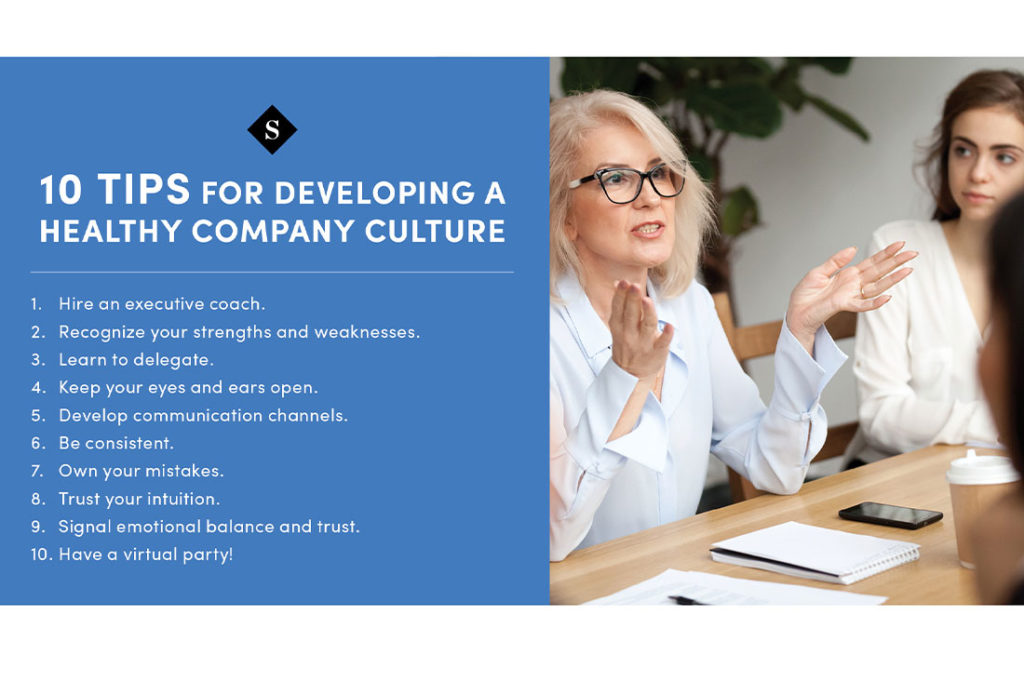You started with a great idea, enthusiastic talent and a core group of dedicated believers who felt that you were all in it together. As your company moved from idea to reality, you brought a few more people into the fold, but you hand-picked them and they blended right into the startup culture.
As your company took flight, you added more talent and the organization grew from a “we all do whatever’s necessary” mindset to the beginnings of defined roles. Perhaps the CEO doesn’t know everyone anymore. And perhaps instead of a couple people who started a company, there’s now a C-suite and another layer of management on the way. An org chart is in the works, but it’s a bit messy. Some people are having trouble letting go, and the new folks are confused about whom they report to.
Success is on the horizon, but obstacles abound. How does leadership maintain the enthusiasm and the positive pieces of startup culture as the company matures? What skills does it take, and how can you instill the company’s philosophy and ideals in new hires? How does the newly minted HR department choose candidates who not only can do the work, but who will flourish and help spread the company culture?
It takes more than business sense to develop a thriving business whose workers are happy to be there. Some of the biggest factors determining a company’s success are features of emotional intelligence: Leaders must be able to look both inward and outward as they transition their companies.
“Broadly, leaders need to be socially aware, to understand others and take an active interest in their concerns. It’s easy to get focused on the business itself and lose sight of the initial connection,” says Melvin L. Smith, a professor in the department of organizational behavior and faculty director of executive education at the Case Weatherhead School of Management.
The first step toward that goal, says executive coach and C-suite search expert Caroline Stokes, is simply acknowledging the shift. Leadership needs the emotional intelligence to step back and think about how employees, both the newly hired and the stalwarts, are blending together so the company culture doesn’t suffer.
“When organizations go from startups into more mature ventures, they lament the loss of that kind of startup mentality. People talk about it over drinks,” Stokes says. “Sometimes they haven’t acknowledged that change is here and [they] need to be part of it.”
But once you’ve acknowledged the change, what do you do about it? Let’s look at it from the four domains of emotional intelligence as defined by Daniel Goleman, who (literally) wrote the book on EI: self-awareness, social awareness, relationship management and self-management.
#1 Self-Awareness
Looking inward will help you look outward to your company’s culture. Great leaders know themselves and their own strengths and weaknesses. They are able to examine their own motives and emotions as they move into the growth phase of their business.
But even great entrepreneurs won’t be able to wing it as they move from that startup mindset to a strategic role in which the day-to-day operations are no longer in their hands. To maintain a workplace where employees want to give it their all, founders who become occupants of the C-suite could use some guidance from the outside, such as an executive coach or peer group that can reflect behaviors back to them and offer suggestions for growth.
Benjamin Kittle, co-CEO and founder of the growing debt-relief company Century Services, is working with an executive coach to strengthen his leadership skills. The increased ability to self-monitor made a huge difference to Kittle. “I’ve been able to think about the way I do things. Then I can manage myself because I recognize behavioral patterns.”
Another tool for CEOs is to answer the question, How do I want to be remembered? Tasha Eurich, behavioral psychologist and author of Insight, a book about self-awareness, says this will help leaders create a positive culture around that answer.
Gaining self-awareness helps leaders become more intentional about their role in developing culture. No one is saying that all employees will think you’re the best boss in history, but leaders who use their emotional intelligence to monitor themselves are better equipped to help their companies make the transition with their culture not only intact but thriving.
#2 Social Awareness
Being socially aware requires empathy, or the ability to understand the perspective of others. Some businesspeople are excellent startup founders but flounder during the growth phase. Why? One answer is that as the company payroll increases, they cannot have a personal relationship with every employee and they lose sight of what’s happening below them.
Company culture suffers if leaders don’t recognize that their behavior has to change as the company changes. No longer can they maintain an open-door policy for all employees—there just isn’t time.
But social awareness requires that leadership develop channels to keep the flow of information moving in both directions and take note of all methods of communication. Eurich recommends a group of “loving critics” for a reality check. “If you surround yourself with people who support you and support you enough to tell you the ugly truth about yourself, you will succeed and build the company that you want to build.”
#3 Relationship Management
Great leaders inspire others. They get them to buy into the mission and feel pride in being a part of it. Again, that’s not so hard when it’s you, a few friends and maybe a family member. But as the organization grows, leaders find themselves managing relationships with people they don’t know.
Without a concerted effort at building departmental relationships through thoughtful messaging, workers may feel unappreciated or siloed, and morale and culture suffer.
As founders step away from the day-to-day operations of the business, they need to empower others to make decisions and to communicate honestly to avoid “CEO disease,” an affliction in which employees don’t trust that they can speak their minds and the C-suite ends up with a skewed view of the company and its culture.
To combat that, leaders must signal that they value opposing opinions and new ideas.
“It’s really about respect. Everybody needs to feel safe and psychologically comfortable,” Stokes says. “Everybody has to feel comfortable to say, ‘Hey, do you mind if we talk about this?’”
To develop that culture of openness, Kittle says he models by taking ownership of his own errors and explaining how he will work to rectify them. That requires communication.
Creating systemic and regular channels for communication is non-negotiable. This can come in many forms from department lunches with the CEO or management, town hall-style meetings or regular surveys of employees. (An Explorance survey on why employees are leaving their jobs in droves found that 78% of workers would love to take a survey about their work environment.) No matter the method, employees must feel they are being heard. That means acknowledging and taking action on feedback.
#4 Self-Management
Microsoft CEO Steve Ballmer may have had a famous temper tantrum (or two), and Apple founder Steve Jobs was well-known for his outbursts, but their model is not the one to follow as a company grows. Quick tempers promote a culture of fear. Entrepreneurs who want to grow their business instead should learn to manage their emotional reactions and other behaviors that define company culture.
If an organization’s startup culture includes open discussion, leaders must be able to think about the message they are sending before they react. But more than that, they need to manage their time and enhance the planning, prioritizing and goal-setting skills that allow them to work efficiently and effectively. Company culture relies on all members of the organization understanding what to expect, how to behave and the best way to function. Employees look to the top for that information.
“A lot of EI is all about consistency of demonstration of certain behaviors,” Smith says. “Largely it’s a lack of consistency—not learning how to do it, but to do it with more consistency.” If people don’t know what to expect or how leadership will respond to any given situation, company culture will erode.
Visionary leaders whose staff stays content set strategic goals and close the door when they need time to focus or manage their responses.

Maintaining the Culture in Remote Times
Employees may not be able to head to the foosball table when they are working remotely, but that doesn’t mean camaraderie-building is impossible.
Trivia nights, virtual happy hours, Slack channels—or, as Century does, a virtual movie night of silly films complete with chat box for a running commentary—all encourage cohesiveness and allow personality to show. That, in turn, opens the door to better collaboration.
Can company culture splinter or become multi-faceted and harder to manage when the office is mostly empty (or doesn’t exist at all)? Yes. That’s why being tuned in is so important for culture. Emotional intelligence guides an understanding of the diverse needs of individuals and departments.
Hiring the Right People
The move from startup to larger company also means leaders have to let go and learn to delegate. Gone are the days of everyone pitching in to do everything. Piling too much on their plates adds to stress and gives employees the feeling that their ideas and talents are underappreciated. Leaders must learn to be more strategic and turn over the tactical to others.
“I was really bad about bringing up an idea and then putting them on a to-do list for myself,” he says.
“Now we have to be much more organizationally structured. I have to come up with ideas and then give them to someone else to figure out.”
To ensure they are the right people, use that emotional intelligence and go with your gut, Smith says, and Stokes agrees.
“Usually CEOs are able to see from previous experiences exactly what a person can bring and see that person’s blindspots,” Stokes says. “It behooves the headhunter, human resources and the CEO to understand the culture.” This helps them find talent who will add to both the environment and the goals of the organization.
Companies are living, changing communities. The qualities of a great entrepreneur differ from those of a great midsize company CEO. Cultural shifts happen, but leaders who have emotional intelligence and are willing to grow with their companies can make the move without losing the can-do spirit of their startups.
This article originally appeared in the March/April 2022 Issue of SUCCESS magazine. Photo by @Irrmago/Twenty20








